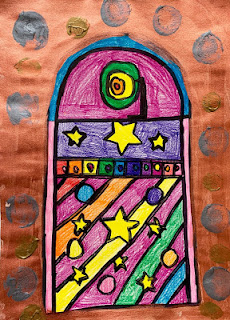Jukebox Drawings
Learning Targets
I can...
- Create an original Jukebox Drawing using observational techniques learned in class
- Use metallic colors (bronze copper silver), line types (curved arched parallel), and value (lightness darkness) inspired by Jukebox Inventor (1864-1936) Louis Glass
- Use drawing techniques (perspective parallel lines horizon line) and design principles (composition proportion repetition) based on Antique Art
- Define Expressive (conveying a thought or feeling in an image)
Lesson One
Day One, Art Start
1. Jukebox AMI Modell JAJ 200 (1959) Automatic Musical Instruments Incorporated, Grand Rapids, Michigan (USA)
2. Listen To Don't Rock The Jukebox by Alan Jackson
3. Discussion Questions "Do you think can name any popular Jukebox songs? In which year was the first jukebox installed in a San Francisco salon? Which of the following was not one of the three major jukebox manufacturers? Which decade were Jukeboxes the most popular? When was the heyday of the jukebox? What technology do modern jukeboxes use? How do records work? Where is the nearest jukebox to you? Where should you look? If you could design a modern jukebox today, what would like look like? What technology would you choose for it? How much would it cost to play a song? When and where was the jukebox invented? Who invented the jukebox in 1927? How old is the jukebox? How many songs are in a jukebox?"
Lesson Activities
1. Choose 8" X 12" Drawing Paper
2. Add line types (contour outline sketching) to positive space (foreground) of the jukebox drawings
3. Outline positive space (jukebox) with metallic colors (gold silver copper bronze) of the jukebox drawings
Day Two, Art Start
1. Retrieve Jukebox Drawings for Assigned Table
2. Wurlitzer Model 1015 Jukebox (1946-1947) Henry Ford
3. Discussion Questions "How do people express meaning through music? How do people interpret meaning in music? How does music reflect the time and place in which it was created? What factors influence an artist's work? How can music or art communicate a theme? How do artists tell stories and convey messages in their work? How did this music make you feel? How would you describe this artwork? Where do we experience music? What music do you enjoy playing for fun? How does music and art evoke emotions? How do the fine arts use conflict and harmony to help show emotion? How do we experience conflict and harmony through the different arts disciplines?"
Lesson Activities
1. Use metallic colors (bronze silver gold) to fill in the positive space (foreground) of the jukebox drawings
2. Use metallic colors (bronze silver gold) to fill in the negative space (background) of the jukebox drawings
3. Use metallic colors (gold silver bronze) to outline the negative space (background) of the Jukebox Drawings
Day Three, Art Start
1. Retrieve Jukebox Drawings for Assigned Table
2. Set Up Studio Area (pencils erasers metallic paint)
Lesson Activities
1. Add highlights (light source, reflective light) to fill in the positive space (foreground) of the jukebox drawings
2. Add shadows (reflective shadows, cast shadow) to fill in the negative space (background) of the jukebox drawings
3. Add details to positive space (foreground) and negative space (background) of Jukebox Drawings























